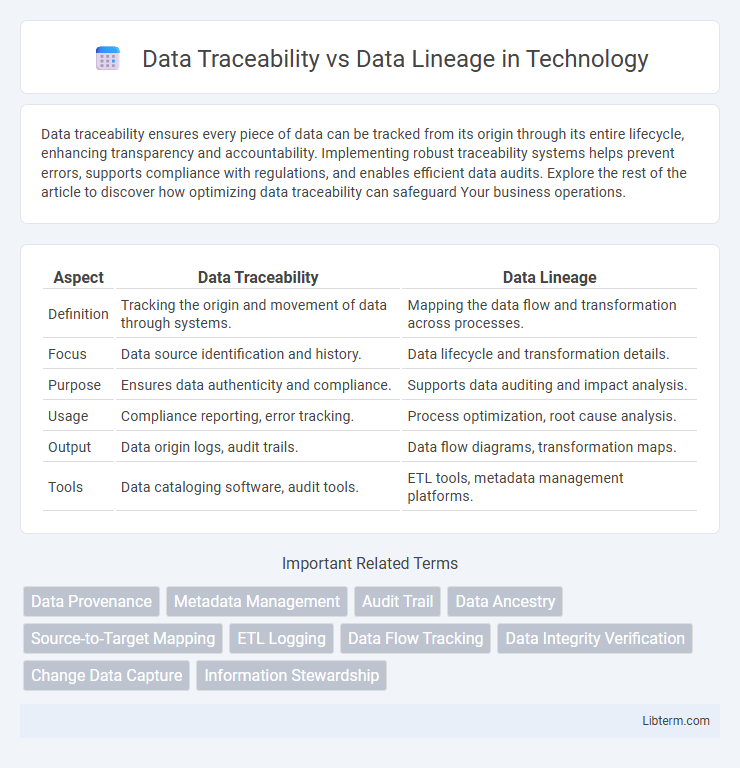Data traceability ensures every piece of data can be tracked from its origin through its entire lifecycle, enhancing transparency and accountability. Implementing robust traceability systems helps prevent errors, supports compliance with regulations, and enables efficient data audits. Explore the rest of the article to discover how optimizing data traceability can safeguard Your business operations.
Table of Comparison
| Aspect | Data Traceability | Data Lineage |
|---|---|---|
| Definition | Tracking the origin and movement of data through systems. | Mapping the data flow and transformation across processes. |
| Focus | Data source identification and history. | Data lifecycle and transformation details. |
| Purpose | Ensures data authenticity and compliance. | Supports data auditing and impact analysis. |
| Usage | Compliance reporting, error tracking. | Process optimization, root cause analysis. |
| Output | Data origin logs, audit trails. | Data flow diagrams, transformation maps. |
| Tools | Data cataloging software, audit tools. | ETL tools, metadata management platforms. |
Understanding Data Traceability
Data traceability ensures every data point is tracked back to its original source, enabling precise verification and quality control across complex systems. It facilitates audit trails by capturing detailed metadata, transformations, and movement history, enhancing data governance and compliance. Understanding data traceability is crucial for maintaining data integrity and providing transparency within data pipelines and enterprise environments.
Defining Data Lineage
Data lineage refers to the detailed tracking of data's origins, movements, transformations, and dependencies through its lifecycle within an organization. It provides a visual and technical map that shows how data flows from source systems to final outputs, enabling transparency and impact analysis for data governance. Understanding data lineage is crucial for compliance, debugging data issues, and ensuring data quality in complex data environments.
Key Differences Between Data Traceability and Data Lineage
Data traceability emphasizes tracking data origin, transformations, and its lifecycle across systems to ensure accountability and compliance, while data lineage focuses on the detailed visualization of data flow from source to destination for understanding data dependencies and impact analysis. Traceability captures audit trails and data movement for governance and regulatory requirements, whereas lineage provides a graphical representation aiding in data quality and troubleshooting issues. Key differences include traceability's broader scope on data lifecycle management and compliance, contrasted with lineage's specific role in mapping data processes and relationships.
Importance in Modern Data Management
Data traceability ensures the ability to track data origins and transformations, providing a detailed audit trail essential for compliance and error detection in modern data management. Data lineage visually maps data flow across systems, enabling better impact analysis, data quality assessment, and governance. Both are crucial for enhancing transparency, trust, and regulatory adherence in complex data ecosystems.
Use Cases for Data Traceability
Data traceability is critical for regulatory compliance, enabling organizations to track data origin, transformations, and access across complex systems. Common use cases for data traceability include audit trails for financial reporting, ensuring data integrity in healthcare records, and tracking changes in supply chain data for transparency. It supports risk management by providing detailed visibility into data flow, which is essential for data governance and forensic analysis in case of data breaches.
Benefits of Data Lineage in Analytics
Data lineage provides a clear visualization of data flow from source to destination, enhancing data accuracy and trustworthiness crucial for robust analytics. It enables quick identification and resolution of data quality issues, reducing downtime and ensuring reliable insights. Detailed lineage supports regulatory compliance and audit requirements, thereby improving transparency and governance in data-driven decision-making processes.
Challenges in Implementing Traceability vs Lineage
Implementing data traceability faces challenges such as ensuring comprehensive data capture across diverse systems and maintaining data integrity throughout its lifecycle, while data lineage implementation struggles with accurately mapping complex data flows and transformations in real-time environments. Traceability requires robust metadata management and standardized protocols to track data origins and usage, whereas lineage demands sophisticated tooling to visualize dependencies and handle dynamic data pipelines. Both require overcoming scalability issues and integrating with existing data governance frameworks to provide transparent, auditable data provenance.
Tools and Technologies Supporting Data Traceability
Data traceability is supported by tools such as Apache Atlas, Collibra, and Informatica, which enable detailed tracking of data origin, transformations, and movement across systems. These technologies integrate metadata management, automated data cataloging, and audit trails to ensure compliance and enhance data governance. While data lineage tools focus on visualizing data flow and dependencies, traceability tools emphasize comprehensive tracking to support regulatory requirements and data quality management.
Compliance and Governance Considerations
Data traceability provides a detailed record of data origins and movements crucial for auditing and regulatory compliance, ensuring organizations can track data sources and transformations to maintain transparency. Data lineage maps the data flow across systems and processes, supporting governance by illustrating how data evolves, enabling impact analysis and risk management. Both are essential for meeting compliance standards such as GDPR and HIPAA, as they facilitate accurate data stewardship, consent management, and accountability in data handling practices.
Choosing the Right Approach for Your Organization
Data traceability and data lineage both track data's journey but differ in scope and application; data traceability focuses on tracking data usage and compliance at granular levels, while data lineage provides a broader overview of data flow and transformation across systems. Organizations prioritizing regulatory compliance and audit readiness benefit from data traceability solutions, whereas those emphasizing data quality, governance, and impact analysis should invest in data lineage tools. Selecting the right approach depends on your organization's specific needs regarding precision, transparency, and the complexity of your data environment.
Data Traceability Infographic

 libterm.com
libterm.com